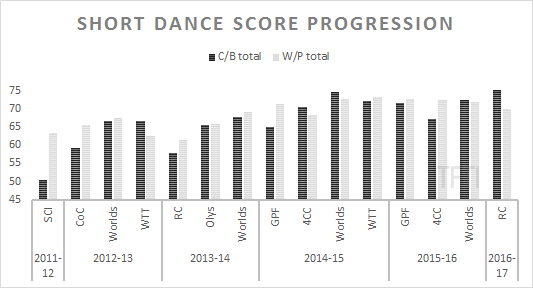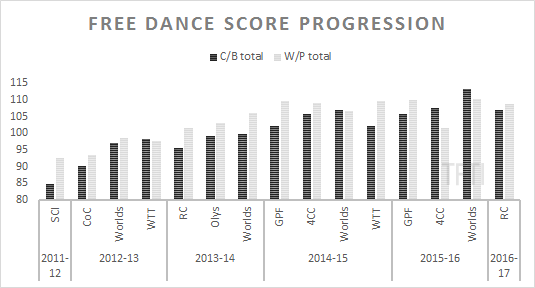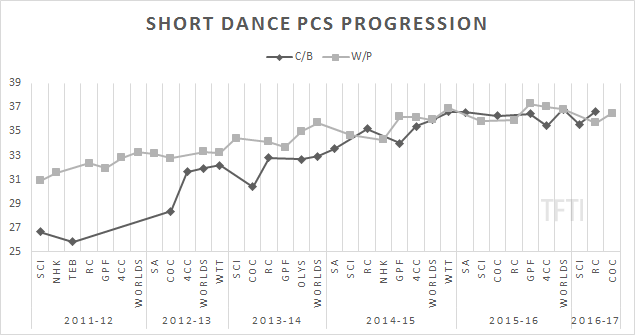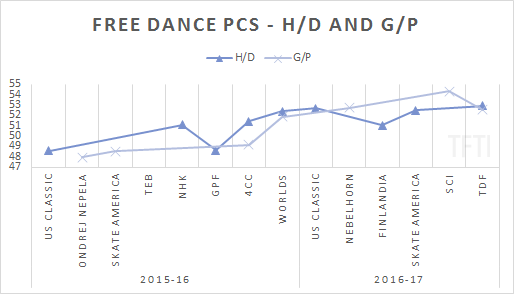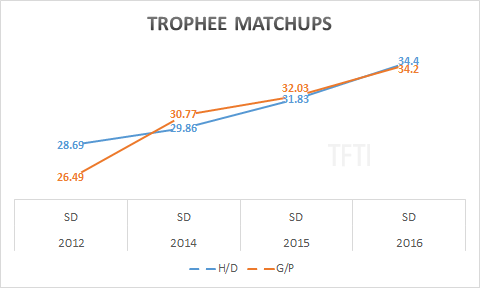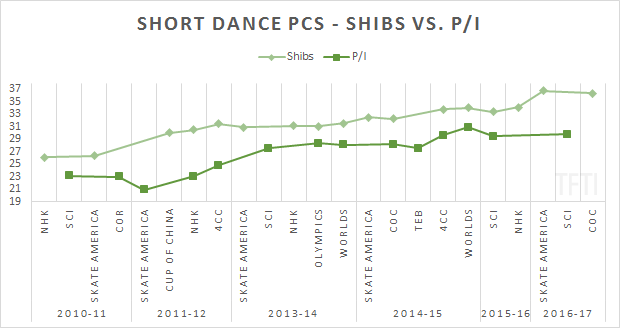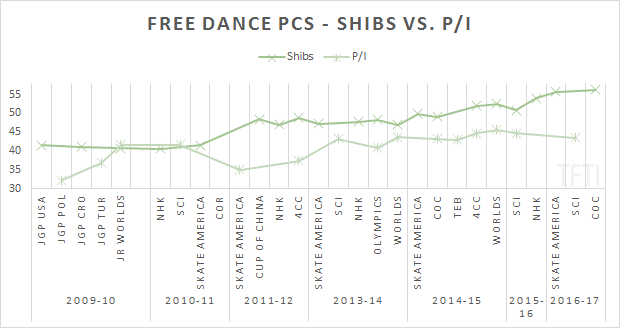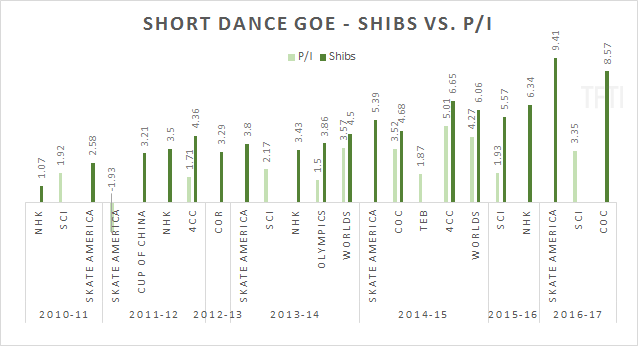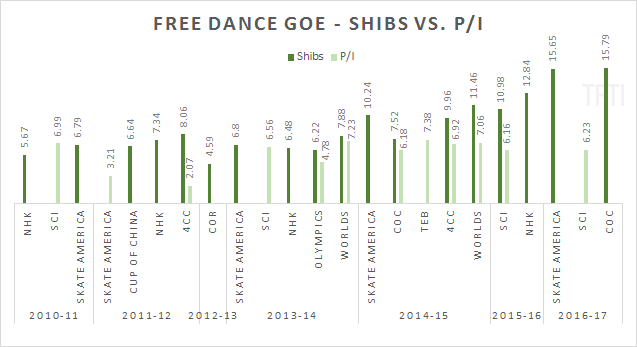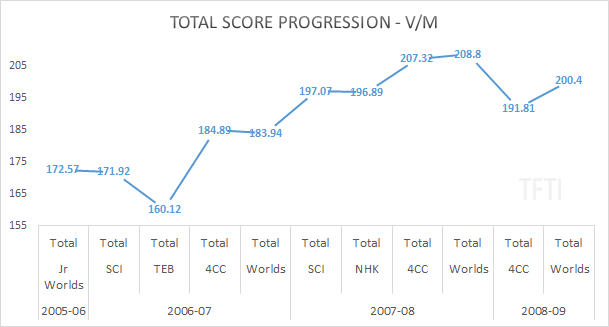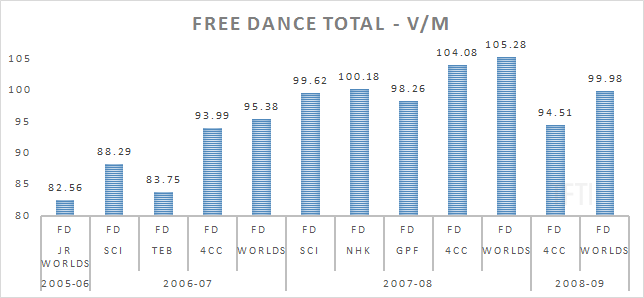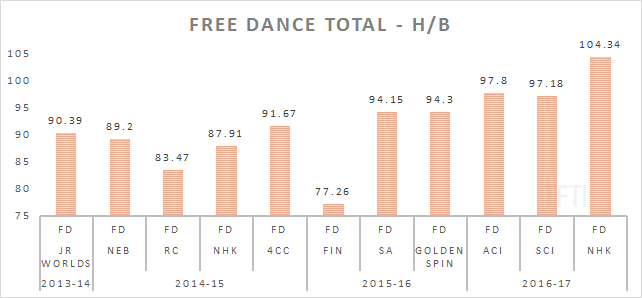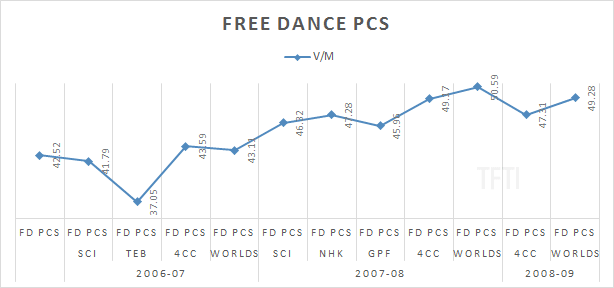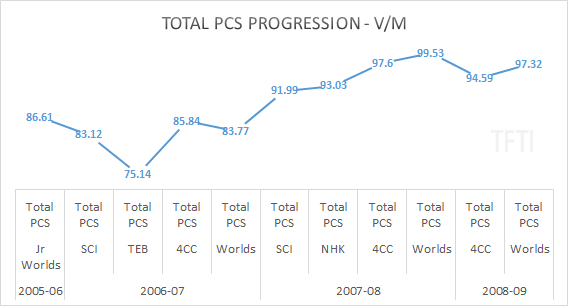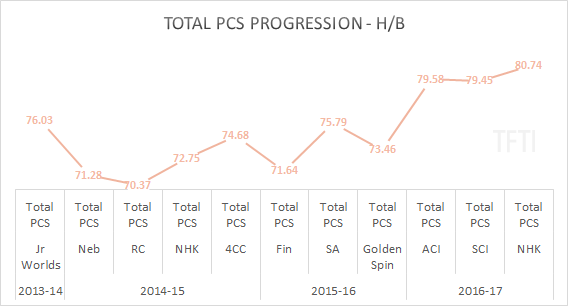by Jacquelyn Thayer
This Grand Prix ice dance team-by-team analysis has been expanded from recent Snapshot Stats features on Two for the Ice on Tumblr.
A pair of world medalist teams in an oft-unsteady position: Madison Chock and Evan Bates ceded the U.S. national title to Maia and Alex Shibutani last year, while Kaitlyn Weaver and Andrew Poje missed the world podium after two consecutive trips. The ascension of the Shibutanis (who took a place ahead of Chock and Bates on that world podium) and return of Tessa Virtue and Scott Moir mean this fall’s results, though not final determinants, do possess at least some symbolic importance for both.
And so, too, it’s significant that these teams matched up at Rostelecom Cup, a fourth season international for the Americans and a season debut for the Canadian team making a few major changes to their training base and coaching staff. Chock and Bates took this round, as they have a few others in recent days — but the journey to close that initial gap, as a comparison of the above and below charts suggests, often had more to do with technical marks than components:
While Chock and Bates first outpaced the far longer-tenured Weaver and Poje in head-to-head competition at 2013 World Team Trophy, taking the short dance by 4.12 and the free by 0.71, it was only in the 2015 Worlds free dance that they could first claim a PCS victory — 54.99 to Weaver and Poje’s 54.87. This was again reversed at World Team Trophy weeks later; last season, Chock and Bates’ best component marks against the Canadians came with a tie in the 2016 Worlds short dance and a 0.07-point edge in the free dance, despite besting Weaver and Poje by 3.76 overall.
PCS trends and overall finishes are, for now, plainly in Chock and Bates’ favor in direct competition. But with such changeable results between these couples in recent seasons — and the early advantage for the Americans of extra competitive feedback, as Weaver and Poje’s own numbers grew by Cup of China — the tide may well turn yet again come spring.
Inspired by any number of motivations — perhaps even Gilles and Donohue’s long-ago ill-fated pairing — the ISU has seemed particularly keen on pitting Madison Hubbell & Zach Donohue and Piper Gilles & Paul Poirier against one another in match-ups. Certainly the teams share other commonalities: both formed in the busy re-matching summer of 2011 (though Gilles and Poirier only competed internationally beginning with the 2012-13 season), three of the four trained at some time at the Detroit Skating Club, and all four had reasonable to strong success as juniors in previous partnerships.
Still, it seems a less than adequate explanation for six Grand Prix head-to-heads in five seasons, including four at the French Grand Prix. Below, a quick look at their PCS by the Trophée year and segment:
Over the last two seasons, their component fortunes have taken turns — including a trend borne out at this event that may come as a surprise given the unenthusiastic reception for Hubbell and Donohue’s short dance. But it may not be a cause for much greater optimism given twizzle errors for Gilles and Poirier in that same segment; though similar performance mistakes have actually goosed the Canadian team’s PCS in the past, trends this season show the mark here to be a low outlier for them, and tech marks for the couples have followed a similar path to those of the components. Hubbell and Donohue notched a Grand Prix Final berth — in part, it’s true, due to besting Gilles and Poirier — but Gilles and Poirier have a 6.8-point advantage in season’s best total. Nationally, Gilles and Poirier are closer to those two teams ahead of them — besting reigning Canadian champs Weaver and Poje in some international season marks — than Hubbell and Donohue to USA’s one and two, but January still awaits. With these teams, making any sure predictions of the sport’s direction is a fool’s game.
Maia and Alex Shibutani and Kaitlyn Weaver and Andrew Poje, one-two at this week’s Cup of China, have shared several events over the years. But they’re not the teams who first faced off in junior ranks, one succeeding the other as World Junior silver medalists while that first team placed fourth.
Unfortunately, a last-minute withdrawal for Alexandra Paul and Mitch Islam at Cup of China curtailed the intended, fuller comparison in these graphs — but also, in its odd way, seemed a fitting addition to this brief analysis. Competitions here have been selected as provide best comparisons: championships and the Grand Prix circuit only when both teams have attended at least one series event that season.
What may be most surprising to some viewers of these two teams is the reminder — or revelation — that their paths tracked far more closely in the earliest days, at least as the free dance is concerned (I begin the short segment with 2010-11, rather than include 2009-10′s compulsory and original dance segments). The Shibutanis, junior national champions in 2010, world medalists in 2009, closed out their junior days as a very good team grappling with height difference, seeing not a diminution in marks but perhaps a minor stagnation. Paul and Islam came from the ashes of two prior good partnerships with decent (though few) international placements; after joining forces in January 2009, their progress was quick and reputation-building quicker. One can accept or challenge their relative components by Junior Worlds — where they closely passed the more established siblings — but the trajectory to get there built over the JGP, helped further by their own national title.
More interesting is to note that for the free dance, this trend carried through into the teams’ first senior Grand Prix circuit in 2010. Indeed, while the Shibutanis made a splash quickly, medaling at both events — despite a costly fall in the short at their first Grand Prix — Paul and Islam overcame a middling short dance performance to score an event-best TES and second-best overall score in the Skate Canada free dance: a suggestion that both teams were carrying through on their junior promise. The Canadian team, though, had their circuit cut short with an injury at their second event — a story that would become familiar to viewers and officials alike.
The Shibutanis captured national silver in their first senior event — even taking the free dance best TES themselves — Paul and Islam bronze in a field that excluded the soon-to-return Tessa Virtue and Scott Moir. This meant 4CC and Worlds opportunities for the Americans, who certainly seized every opening at both, while Paul and Islam could stand only as first alternates.
The graphs and careers diverged with 2011-12 and subsequently, barring a few deviations thanks to very strong or unusually weak outings, the tracks have remained quite distant. Though the Shibutanis faced the challenges of defending world position after a surprise early world bronze — and would spend several seasons addressing, too, hiccups of injury and the search to find their best creative footing — their basic skating foundation was strong, and stronger as the young team became better-matched as adults. Paul and Islam, conversely, spent that 2011-12 season in a wilderness of calamitous injury and the occasionally calamitous skate, both of which impacted confidence in performance and almost certainly impacted perception of even clean skates that year. There’s a received wisdom in the world of skating that publicizing injuries is a way of asking for extra scrutiny; when those injuries occur in public, event-impacting ways, scrutiny might be unavoidable. A look at GOE tracks for both teams reveals a little more than PCS alone, and added here for additional context is 2012 Rostelecom Cup for the Shibutanis, where the team had a mid-program stoppage and finished off the podium for the only time in their Grand Prix career.
(Recall that Grade of Execution values increased with the 2014-15 season.)
Despite Paul and Islam’s move to train in Detroit and the real improvements that came with it, occasional, significant mistakes came, too — not fatal for teams with a firmer international footing, but grave indeed for one with a more wobbly base. And good to excellent skates may be judged more cautiously when a team or individual skater brings baggage like a reputation for error, just as the notoriety of early overachievement can prove its own burden. A gap of some extent between these teams is correct; worth considering more is the range of component marks for those ranked between them.
As of Cup of China, the Shibutanis’ total PCS has increased by 39%, or 25.98 points, since their first senior Grand Prix at 2010 NHK Trophy. At last month’s Skate Canada International, Paul and Islam’s total PCS revealed a 13% increase, or 8.52 points, from 2010′s same event. The early career past is not always prologue.
NHK Trophy marked the third shared event this young season for Canada’s Tessa Virtue and Scott Moir and USA’s Kaitlin Hawayek and Jean-Luc Baker — two couples who share the distinction of capturing World Junior titles in an Olympic season.
In terms of results, it might be easier to compare Virtue and Moir’s first senior quad with that of France’s (World Junior silver medalists) Gabriella Papadakis and Guillaume Cizeron. But let’s instead consider the question of how a pair of very successful North American juniors positioned themselves in a new senior field, entering a new Olympic quad.
Rendering difficult a direct comparison here is the seismic shift within the sport of ice dance itself since Virtue and Moir’s early years: the collapse of the compulsory and original dances into the short dance means total scores, like those given above, can only be charted for overall trajectory — suggesting few commonalities between the teams. So we’ll look instead at the free dance alone, which tells a bit of a different story in this comparison:
Although PCS factoring has changed very slightly since 2014 — factors were actually identical from the earliest point examined here through Hawayek/Baker’s Junior Worlds skate — it’s unlikely to have made a significant contribution to increases or decreases in that data per team. TES, on the other hand, tends to swing dramatically given not only changes to a free dance’s required elements, but also major alterations to Base Value over the seasons. So what say the components alone?
With high and low removed, Virtue and Moir’s average free dance PCS from Junior Worlds through their first three senior seasons was 45.63; Hawayek and Baker’s, through NHK Trophy, is 45.8. Personal achievement for these teams is not so far removed; context, however, has been fundamental. Virtue and Moir had the luxury of entering an aging field, a wide-open Canadian landscape, and the first post-IJS quad, where youth and development within the new system were bound to be rewarded as much as talent. The post-Sochi quad, conversely, has been one little changed from the prior era; younger teams mean more of waiting one’s turn (especially in a crowded American field), while other kinds of novelty have been recognized after the recent dominance of the Detroit school. This has also had the effect of forcing scores upward; the same high marks of a little under a decade ago are now good, but no longer world-beating.
Virtue and Moir captured Olympic gold at the conclusion of their first senior quad. It’s unlikely Hawayek and Baker will follow in those large footsteps — but with enough time and patience, they should feel good about their trajectory thus far. Even a look at total PCS development suggests more commonalities than one might expect:

